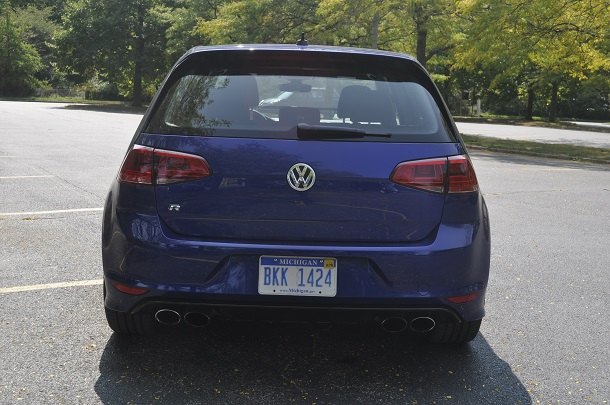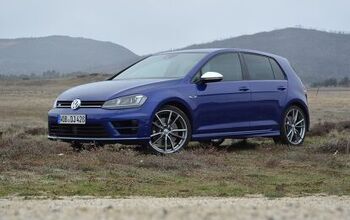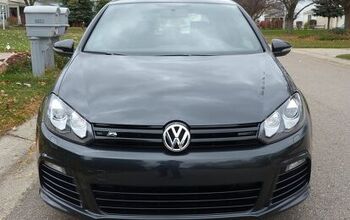2017 Volkswagen Golf R Review - Performance at a Price

2017 Volkswagen Golf R
Not long ago, I wrote glowingly about the new Honda Civic Type R. Part of my praise was based on the fact that the Type R is bargain-priced compared to its competition.
Yeah, I liked the Type R. A lot. Even took a little crap in the comments for it (fair enough). But again, a big reason for my praise was the price. If the Type R was stickered the same as its three main competitors – the Ford Focus RS, Subaru WRX STI, and Volkswagen Golf R – would it still be “all that?”
On its own merits, sure. It’s very, very good. Great, even. But a strong argument can be made that all things being equal, the Golf R is even better. And I’m about to make it.
For starters, the Golf R (technically, Golf R DCC with Navigation; DCC stands for Dynamic Chassis Control) is almost the opposite of the Type R and the other two hooligans in the class, despite having the same mission. Yes, it’s a powerful, sporty compact that offers a stick shift. Yes, like two of its rivals, it has all-wheel drive. It has a pleasing exhaust note and a sport-oriented drive mode.
But unlike the other three cars, it blends. Only VW fanboys will notice it in traffic. Outside of badging, wheels, four exhaust outlets with chrome pipes, rear spoiler and a low ride height – lower than both the base Golf and the mid-performance GTI – there’s not much to obviously differentiate the car from “lesser” Golfs. Yes, there are other visual cues – side skirts, rear diffuser, different bumpers (the front has larger air inlets), different grille, and bi-Xenon headlights, but the average passerby probably won’t notice you’re driving an R.
Perhaps the biggest giveaway is the soundtrack — the exhaust note definitely offers a pleasing performance note. Still, it’s less noticeable, even during hard driving, than the sounds emanating from the RS and STI. It sounds great but probably won’t draw unwanted attention from the local law.
The Golf R doesn’t just sound great. It moves with urgency, thanks to 292 horsepower and 280 lb-ft of torque from the 2.0-liter turbocharged four-cylinder. It might take a tad longer to dig into the power than the others, but that’s the kind of difference that’s really only noticeable at the track. In daily driving, the R feels just as responsive when it comes to acceleration.
The Golf R is available with either a six-speed manual transmission or a six-speed DSG automatic. The six-speed stick is one of the better ones out there, although the throws are a tick long. Whether in daily driving or when driving hard, it’s pleasant to work with, and the clutch has good takeup and feel without wearing out your legs.
Balance is a key attribute of the Golf R – its ride is sedate enough when commuting while sacrificing nothing in terms of handling. Like most modern cars it offers up a choice of drive modes – normal, comfort, race, and custom – I found normal to be the best for most situations. Race tightened things up nicely when I chose to be more aggressive. Comfort, however, was a bit of a letdown. Sure, one expects looser steering and other less-taut responses when choosing this mode, but the R took it further than one would expect from a car with this kind of sporty intent.
Otherwise, the R’s steering is nicely weighted, amenable to quick adjustments, and accurate. Like the ride, the handling strikes a nice balance – there’s that word again. The R is just predictable and unflappable while turning. Thank its sport suspension, which is a strut-type with lower control arm up front and multi-link in the rear, for that. As for the upgraded brakes, I noticed no issues (though I also had no chance to really fully challenge them).
Perhaps this car’s biggest strength is also its biggest flaw. It’s such a great sport compact for daily driving precisely because it’s not quite as hopped up as its competition. It doesn’t have the same level of seat bolstering as the RS and Type R, for one thing. Sure, there’s a spoiler and other aerodynamic doo-dads, but it’s unclear from the press materials how much of their presence is meant to assist performance, and how much is meant purely for styling.
All this really means is that the Golf R feels less track-focused than the others, at least out of the box. And for most buyers, that’s fine, even preferable. Besides, it’s not like there isn’t an aftermarket that exists for those who’d love to track their Golf R. But some folks will prefer to start with a car that offers more goodies from go.
The Golf’s sleeper status will polarize, too – while some buyers will prefer to move about the world in stealth, others might like a little more showmanship. To be sure, the Golf R’s interior doesn’t feel particularly different from the GTI, despite all the little “R” touches Volkswagen gives it. Yeah, the pedals and flat-bottomed steering wheel look cool (and to be fair, the GTI also has a similar steering wheel and pedal setup), and so do some of the other trim bits, but again, only enthusiasts are really going to notice most of the changes. Being subtle sometimes goes unappreciated.
Too much subtlety aside, the interior is otherwise pretty nice. The leather surfaces look and feel good and the power driver’s seat makes getting settled easy. I was, however, mystified by the non-opening center console. This leaves interior storage at a premium – you get the glovebox, a sunglasses holder mounted on the ceiling, and a small cubby ahead of the shifter that also houses the USB port.
Cargo space is unremarkable, and the rear seat was tight but accessible. Headroom is generous up front and fair in back. If you want a sunroof, sorry, you can’t get one.
Like other cars in this class, especially hatchbacks, road noise becomes an issue at highway speeds. The Golf R feels somewhat quieter than the others, subjectively speaking, but it is still pretty noticeable.
Most of the Golf R’s other flaws are present in other Golf/VW models. The infotainment unit is easy enough to use, but it requires way too much flipping from menu to menu to engage fairly basic functions (example – if you have the factory nav screen up but want to manually tune the radio via the knob, you have to switch to the radio menu first). The Park Pilot driver’s assist system is too intrusive, often beeping and booping (and lowering the radio volume) when it’s not really needed – a curb in the driveway leaving my building caused it constant confusion and consternation.
Speaking of driver’s aids, in addition to Park Pilot, the Golf R comes with adaptive cruise control, forward-collision warning, autonomous emergency braking with front assist, lane-departure warning, rearview camera, and high beam control.
Convenience features are pretty standard, too – heated front seats, satellite radio, USB, Bluetooth, navigation, and smartphone integration are the highlights here. You also get six airbags.
I didn’t measure fuel economy, but it’s listed at 22 mpg city/31 mpg highway for the stick and 23/30 with the DSG.
Considering the Golf R on the whole, it’s probably the best of the bunch for all-around duty. It’s more refined and less high strung than the STI and Focus RS, and it looks better than the divisive Type R while providing a similar on-street driving experience. It’s perhaps less track-oriented than the rest, but as noted, most buyers aren’t going to care.
Price is where it gets sticky. My tester came in at a reasonable-seeming $40,195 with fees. That’s higher than a base Focus RS by about $4K, but adding options to that car makes the price jump quickly – I got one up to $44K on the consumer configurator, and the last one I drove was $42,245, thanks to $5,470 in options, plus fees.
The STI starts at a few hundred bucks more than the Golf R, and fees add on about another $1,000. That car only offers one option package, though – the no-cost wing delete – so pricing is dependent on how you accessorize. Adding just about every accessory you can would put you close to $50K, but few buyers are going to go that hog-wild with the accessories box. Keep it reasonable, and you’re in the low-to-mid $40K range.
Volkswagen also offers accessories for the Golf R, and if none of them tickle your fancy, you can have your Golf R for the same price as my test unit. A decent price, although VW could stand to offer certain features, such as a sunroof.
Which would be (mostly) a bargain, if not for that pesky Type R being priced at under $35K, including fees. All of this figuring does, of course, ignore dealer markups (which can happen in this segment). Also, the Honda will only sell 5,000 Type Rs per year. Not to mention that the Honda’s looks are, well, controversial.
For the best blend of daily driving, blend-in looks, and performance, the Golf R remains king. The other three might be better on track, and one is significantly cheaper, but for the compact sports car buyer who wants to best all-round vehicle with the fewest tradeoffs, the Golf R is the best choice.
[Images © Tim Healey/The Truth About Cars]

Tim Healey grew up around the auto-parts business and has always had a love for cars — his parents joke his first word was “‘Vette”. Despite this, he wanted to pursue a career in sports writing but he ended up falling semi-accidentally into the automotive-journalism industry, first at Consumer Guide Automotive and later at Web2Carz.com. He also worked as an industry analyst at Mintel Group and freelanced for About.com, CarFax, Vehix.com, High Gear Media, Torque News, FutureCar.com, Cars.com, among others, and of course Vertical Scope sites such as AutoGuide.com, Off-Road.com, and HybridCars.com. He’s an urbanite and as such, doesn’t need a daily driver, but if he had one, it would be compact, sporty, and have a manual transmission.
More by Tim Healey
Latest Car Reviews
Read moreLatest Product Reviews
Read moreRecent Comments
- ToolGuy This thing here is interesting.For example, I can select "Historical" and "EV stock" and "Cars" and "USA" and see how many BEVs and PHEVs were on U.S. roads from 2010 to 2023."EV stock share" is also interesting. Or perhaps you prefer "EV sales share".If you are in the U.S., whatever you do, do not select "World" in the 'Region' dropdown. It might blow your small insular mind. 😉
- ToolGuy This podcast was pretty interesting. I listened to it this morning, and now I am commenting. Listened to the podcast, now commenting on the podcast. See how this works? LOL.
- VoGhost If you want this to succeed, enlarge the battery and make the vehicle in Spartanburg so you buyers get the $7,500 discount.
- Jeff Look at the the 65 and 66 Pontiacs some of the most beautiful and well made Pontiacs. 66 Olds Toronado and 67 Cadillac Eldorado were beautiful as well. Mercury had some really nice looking cars during the 60s as well. The 69 thru 72 Grand Prix were nice along with the first generation of Monte Carlo 70 thru 72. Midsize GM cars were nice as well.The 69s were still good but the cheapening started in 68. Even the 70s GMs were good but fit and finish took a dive especially the interiors with more plastics and more shared interiors.
- Proud2BUnion I typically recommend that no matter what make or model you purchase used, just assure that is HAS a prior salvage/rebuilt title. Best "Bang for your buck"!









































Comments
Join the conversation
The fact the sticker price of the Golf R is 10k cheaper than the sticker price on the Focus RS explains why you never see Focus RSes in Canada. Both RSes we had at our dealer had stickers for 51k. Also can someone care to explain why 100% of Golf Rs in existence have non-functional ski racks on the roof which always look completely idiotic?
I really like the Golf R. Intended to buy one last Spring. Ended up with a GTI SE manual for a hair under 27K. Same leather and brakes.Also the electronic diff with 300lbs less weight. Same Fender stereo with CarPlay and Android Auto. For 15K less. For most driving they feel pretty similar. I may still buy an R next year with the larger screen and the virtual cockpit to help differentiate it from the GTI. Until then I feel like I got a pretty good car for a good price.